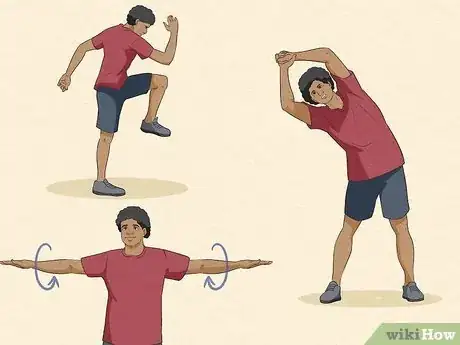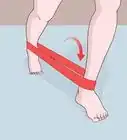This article was co-authored by Kai Ng and by wikiHow staff writer, Madeleine Flamiano. Kai Ng is a USATF and RRCA Certified Running Coach at Run Coach Kai. Kai has competed in over 55 races and over 15 marathons, and has trained with 16x USA and World record holder Patti Catalano Dillonso. He specializes in coaching runners of all levels and showing people that everyone can be a runner. Kai is committed to helping his clients reach their goals by showing them how to run with proper form and holding them accountable to train consistently.
There are 22 references cited in this article, which can be found at the bottom of the page.
This article has been viewed 149,593 times.
Ready to take your first steps to start running? We're here to help you during your cardio journey and path toward wellness. In this article, we'll review how to find the inspiration to get up and moving. Plus, we'll talk about practical measures to take and the best ways to train for cardio so you'll improve your heart and lung health. Jump right in to begin your running adventures.
Steps
Expert Q&A
Did you know you can get expert answers for this article?
Unlock expert answers by supporting wikiHow
-
QuestionHow long should it take a 10-year-old to run 80 meters (1/2 mile)?
 wikiHowOur goal at wikiHow is to deliver trustworthy articles that engage our readers and meet their informational and emotional needs. For 15 years, we've committed to our step-by-step teaching model, and we continue to refine our content to create the best how-to experience on the Internet. We’ve helped millions of people solve problems, learn new skills, and feel supported in the ordinary and complex moments of life.
wikiHowOur goal at wikiHow is to deliver trustworthy articles that engage our readers and meet their informational and emotional needs. For 15 years, we've committed to our step-by-step teaching model, and we continue to refine our content to create the best how-to experience on the Internet. We’ve helped millions of people solve problems, learn new skills, and feel supported in the ordinary and complex moments of life.
The most trusted how-to site on the internet.
-
QuestionI used to be a sprinter last year and I was very fast. However, I stopped practicing and now I don't know if I'm fast anymore even though everyone says I am. How do I get faster again over summer break?
 wikiHowOur goal at wikiHow is to deliver trustworthy articles that engage our readers and meet their informational and emotional needs. For 15 years, we've committed to our step-by-step teaching model, and we continue to refine our content to create the best how-to experience on the Internet. We’ve helped millions of people solve problems, learn new skills, and feel supported in the ordinary and complex moments of life.
wikiHowOur goal at wikiHow is to deliver trustworthy articles that engage our readers and meet their informational and emotional needs. For 15 years, we've committed to our step-by-step teaching model, and we continue to refine our content to create the best how-to experience on the Internet. We’ve helped millions of people solve problems, learn new skills, and feel supported in the ordinary and complex moments of life.
The most trusted how-to site on the internet.
-
QuestionHow do I get motivated to start running?
 Tyler CourvilleTyler Courville is a brand ambassador for Salomon Running. He has run in 10 ultra and mountain races across the United States and Nepal, and won the 2018 Crystal Mountain Marathon.
Tyler CourvilleTyler Courville is a brand ambassador for Salomon Running. He has run in 10 ultra and mountain races across the United States and Nepal, and won the 2018 Crystal Mountain Marathon.
Professional Runner
Warnings
- Consult your doctor before you begin your running program if you have[22]
- Heart, lung, or kidney disease
- Type 1 or 2 diabetes
- Arthritis
- Cancer
- High blood pressure
⧼thumbs_response⧽ - Once you've started running, tell your physician if you notice symptoms like:[23]
- Pain in your chest, neck, jaw, or arms
- Dizziness when you run
- Shortness of breath
- Swollen ankles
- A rapid heartbeat
- A heart murmur
- Lower leg pain while walking
⧼thumbs_response⧽
References
- ↑ https://www.mayoclinic.org/healthy-lifestyle/fitness/in-depth/fitness/art-20047624
- ↑ https://www.dignityhealth.org/articles/the-difference-between-running-shoes-and-walking-shoes
- ↑ https://www.betterhealth.vic.gov.au/health/healthyliving/running-and-jogging-preventing-injury
- ↑ https://www.helpguide.org/articles/healthy-living/how-to-start-exercising-and-stick-to-it.htm
- ↑ https://www.ahealthiermichigan.org/2022/04/26/why-you-should-walk-at-lunch/
- ↑ https://www.kansashealthsystem.com/news-room/blog/0001/01/5k-training-tips
- ↑ https://www.runnersworld.co.za/health/fix-your-posture-fix-your-running/
- ↑ https://news.stanford.edu/2022/04/28/runners-prefer-pace-regardless-distance/
- ↑ https://www.mayoclinic.org/healthy-lifestyle/fitness/in-depth/overuse-injury/art-20045875
- ↑ https://www.mayoclinic.org/healthy-lifestyle/fitness/in-depth/5k-run/art-20050962
- ↑ https://www.hopkinsmedicine.org/health/wellness-and-prevention/the-truth-behind-runners-high-and-other-mental-benefits-of-running
- ↑ https://www.mayoclinic.org/healthy-lifestyle/fitness/in-depth/5k-run/art-20050962
- ↑ https://www.uhhospitals.org/Healthy-at-UH/articles/2022/03/how-much-water-should-you-drink-a-day
- ↑ https://brighamhealthhub.org/hydration-for-runners/
- ↑ https://news.sanfordhealth.org/orthopedics/3-things-runners-need-to-know-about-carbs/
- ↑ https://www.mayoclinic.org/healthy-lifestyle/nutrition-and-healthy-eating/in-depth/water/art-20044256
- ↑ https://www.pennmedicine.org/updates/blogs/musculoskeletal-and-rheumatology/2022/march/preparing-for-a-long-distance-race
- ↑ https://www.ymcamidtn.org/health-and-fitness/articles/ask-rds-when-and-what-should-i-eat-workout
- ↑ https://www.heart.org/en/healthy-living/fitness/fitness-basics/target-heart-rates
- ↑ https://health.clevelandclinic.org/when-and-how-to-start-a-running-program/
- ↑ https://www.lung.org/lung-health-diseases/wellness/exercise-and-lung-health
- ↑ https://ausactive.org.au/wp-content/uploads/2022/02/Adult-Pre-Exercise-Screening-Tool.pdf
- ↑ https://www.mayoclinic.org/healthy-lifestyle/fitness/in-depth/exercise/art-20047414









































































